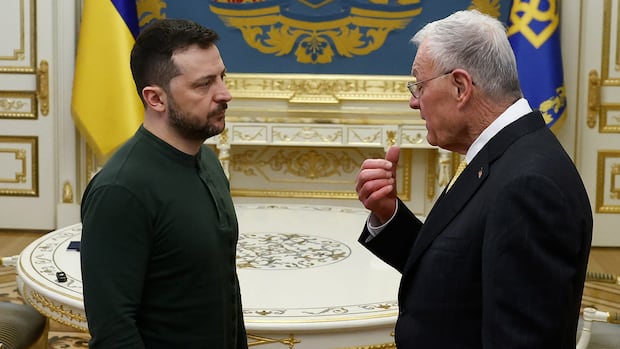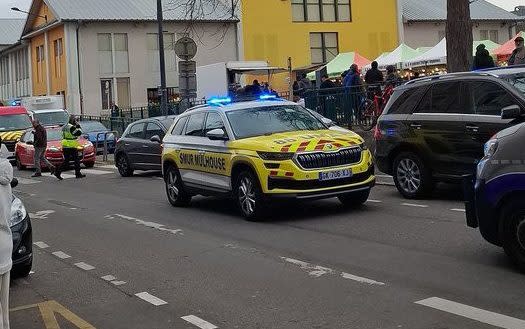Ukraine has honed its army of drones to the point where these tools have become one of its most potent weapons in fighting back against Russia’s full-scale invasion of its borders.
“Right now, the situation on the battlefield is really dependent on drones, and they are responsible for a very significant percentage of the kills on the battlefield,” Mykhailo Fedorov, the vice-prime minister of innovation, told CBC News via a translator.
How significant? A recent report from two research fellows at the London-based Royal United Services Institute (RUSI) suggests Ukraine’s attack drones now account for the majority of Russian losses on the battlefield — and they can be especially lethal when paired with artillery.
These results explain why Ukraine scaled up procurement levels from what Fedorov says started out as thousands of these devices in 2022, up to more than 1.5 million last year.
Fedorov and other officials say virtually all of Ukraine’s FPV (first-person view) attack drones are domestically produced at this point. “Ninety-nine per cent,” he said Friday.
And Ukrainian President Volodymyr Zelenskyy has said the country has built up the capacity to produce four million drones a year.
After days of tense relations and verbal sparring, the White House is pushing Ukrainian President Volodymyr Zelenskyy to allow the U.S. access to Ukraine’s critical minerals as payback for billions spent on wartime aid.
As the all-out war reaches the three-year mark on Monday, Ukraine finds itself with less assured support from the United States, since U.S. President Donald Trump’s inauguration last month. Amid this uncertainty, the fight against the Russian invasion continues, and Kyiv appears inclined to sustain its technology-led approach to the war, given what it faces on the other side of the front lines.
“In principle, right now, we are fighting a drone war,” Fedorov said.
Perpetual ‘shifts and changes’
Despite Ukraine’s successes with these tools, the situation on the ground — or in the air or sea, depending on the type of drone — is constantly changing.
“The battlefield shifts and changes every day,” Fedorov said.
He said private companies have played a key role in driving the drone innovations that have rolled out in Ukraine, as they collect feedback from the men and women on the battlefield and adjust the products accordingly.
“Changes happen literally each week,” Fedorov said.
Oleksandra Molloy, a senior lecturer in aviation at Australia’s University of New South Wales (UNSW) Canberra, said that the world is watching what Ukraine is doing with drones.
“Ukrainians’ advancements in these drone technologies are inspiring a global shift in the perception of UAV (unmanned aerial vehicles) in warfare — through ingenuity, adaptability and also relentless pursuit of innovation,” Molloy said in an interview.
Ukrainian allies are also learning from what is unfolding on the battlefield, but so is Russia, which is developing its own capabilities with drones.
Russian drones have proven a danger to Ukrainian soldiers serving on the front lines, but also to civilians.
The United Nations Human Rights Monitoring Mission in Ukraine reported earlier this month that short-range drones killed more Ukrainian civilians in the month of January than any other type of weapons.
Reports have been mounting that people living near front-line areas on the Ukrainian side are facing threats to their lives from drones on a regular basis.
Reducing risks to soldiers
An emerging area in the Ukrainian war drone space is the use of unmanned ground vehicles (UGV), also known as ground drones.
Like their aerial equivalents, these devices are being used for a variety of purposes on the battlefield — a key one being assistance with logistics.

“Most of our personnel losses are happening during last-mile logistics — for ammunition, for food, for other forms of sustenance,” Fedorov said.
Being able to send a robot to get these things to Ukrainian troops while keeping people safe is “going to be very beneficial” for the war effort going forward, he said.
“Human life, at the end of the day, is critical for us,” said Fedorov, who has previously forecast that Ukraine will need to field tens of thousands of these devices in 2025.
But these ground drones are also being rolled out to deal with mines and other dangerous tasks.

The RUSI report, which looked at tactical developments during the third year of the all-out war between Russia and Ukraine, said that the current mix of ground drones is still a work in progress.
“They are likely to become more reliable, as most technologies do with time, investment and accumulated relevant engineering expertise,” Nick Reynolds, a RUSI research fellow and co-author of the report, told CBC News via email.
‘Drones are here to stay’
UNSW’s Molloy said the all-out war in Ukraine has shown that it’s “absolutely clear” that “the drones are here to stay.”
And she said it’s quite conceivable that future conflicts could begin with drones in place of soldiers.
Fedorov said that Ukraine’s allies are learning from what his country is going through — both the good and the bad.

For instance, some of the drone-involved attacks that Ukrainians are seeing levelled on their cities are novel in nature, and Fedorov said there are lessons to be learned.
“This is probably some of the best value that we can give to our allies and partners who are helping us,” he said. “The experience that we’re sharing allows them to defend themselves better, should an attack come.”
However fatigued Ukrainians may feel, Fedorov said he sees no other choice than to continue to resist the invasion.
“We don’t have a way to just switch it off, so we don’t have an option rather than to hold on,” he said.
“Everybody is, of course, tired — especially the military who are on the battlefield right now. They are doing the hardest job,” Fedorov said. “But there is no other way, other than to generate solutions, to solve problems, to implement projects, to defend ourselves.
“I think we are motivated most by the desire to end this war by stopping the enemy. Nobody wants to have Russia here in Ukraine.”
#Ukraines #homegrown #drones #increasingly #lethal #critical #tools #war #Russia







Leave a Reply